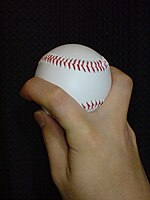
Forkball

The forkball is a type of pitch in baseball. Related to the split-finger fastball, the forkball is held between the first two fingers and thrown hard, snapping the wrist. Due to its movement being similar to that of a spitball, the pitch is often called the "dry spitter".

The forkball differs from the split-fingered fastball, however, in that the ball is jammed deeper between the first two fingers. The result is that the forkball is generally thrown slightly slower than the splitter, but has more of a "tumbling" action akin to the movement of a 12–6 curveball, as it will drop off the plate before it gets to the catcher's mitt.

Use in professional baseball

Joe Bush, a pitcher from the 1910s and 1920s who played for the Philadelphia Athletics and Boston Red Sox, is credited with the invention of the forkball, shortly following World War I.[1]

The pitch has been favored by several current and former major league pitchers, including Tom Henke, Kevin Appier, Hideo Nomo, José Valverde, José Arredondo, Ken Hill, Justin Speier, Kazuhiro Sasaki, José Contreras, Chien-Ming Wang, Junichi Tazawa, Robert Coello, Edwar Ramírez.[2] Notably, Kodai Senga of the New York Mets has an effective forkball, nicknamed the "ghostfork".[3]

Roy Face and Lindy McDaniel were relief pitchers who pitched for 16 and 21 years, respectively, in the Major Leagues and were forkballers. Face started his career in 1953 and McDaniel in 1955. Face singlehandedly made the forkball a topic of popularized discussion through his effective use of the pitch.[4]

Towards the end of his career, the forkball was adopted by Sandy Koufax, Hall of Fame pitcher for the Los Angeles Dodgers, to make up for lost velocity due to his arm injuries and to replace his seldom used changeup which he considered to be ineffective.[5]

References
- ^ "MLB Glossary: Forkball". MLB.com.
- ^ Ryan, Shane (June 28, 2012). "Forkball: The Other Forgotten Pitch". Grantland.
- ^ Curtis, Charles (March 6, 2023). "What is the ghost fork? Kodai Senga's unreal pitch with so much movement, explained". USA Today.
- ^ Chass, Murray (1988-07-17). "Notebook; Whatever It's Called, Forkball or Split-Fingered, It's Screwy". The New York Times.
- ^ Tim McCarver's Diamond Gems. McGraw Hill. 2006. pp. 224–225. ISBN 978-0071545945.
See what we do next...
OR
By submitting your email or phone number, you're giving mschf permission to send you email and/or recurring marketing texts. Data rates may apply. Text stop to cancel, help for help.
Success: You're subscribed now !
